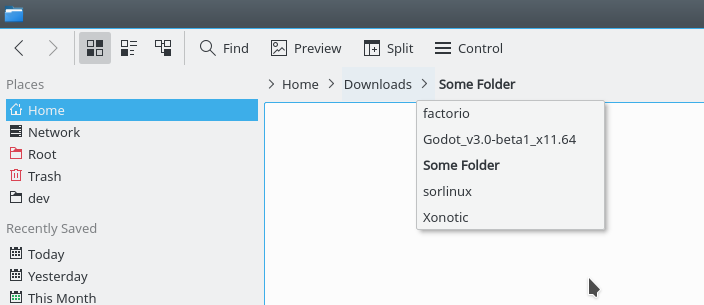Dolphin/File Management/bg: Difference between revisions
Created page with "Между бутони, които представляват папка има една малка стрелка, която е бутон, както добре. Като к..." |
Created page with " 400 пиксела | малка | център | Промяна директории бързо" |
||
| Line 56: | Line 56: | ||
[[Image:Dolphin_nav.png| | [[Image: Dolphin_nav.png | 400 пиксела | малка | център | Промяна директории бързо]] | ||
There is also a classical navigation bar which displays the complete path. To use this style you can select <menuchoice>View -> Navigation Bar -> Show Full Location</menuchoice>, or trigger the keyboard shortcut <keycap>Ctrl + L</keycap>. By clicking on the free space next to the last displayed folder in the breadcrumb style you can change to the classical style as well. If the classical style is selected a checkmark is displayed at the end of the navigation bar. This checkmark is a button which can be used to change back to the breadcrumb style. Of course menu and keyboard shortcut can be used, too. | There is also a classical navigation bar which displays the complete path. To use this style you can select <menuchoice>View -> Navigation Bar -> Show Full Location</menuchoice>, or trigger the keyboard shortcut <keycap>Ctrl + L</keycap>. By clicking on the free space next to the last displayed folder in the breadcrumb style you can change to the classical style as well. If the classical style is selected a checkmark is displayed at the end of the navigation bar. This checkmark is a button which can be used to change back to the breadcrumb style. Of course menu and keyboard shortcut can be used, too. | ||
Revision as of 17:25, 9 January 2011
Открийте "Dolphin"
В първата част "Dolphin ще ви покаже как да работите с него . Вторият раздел се разглеждат с концепциите на различни видове маркери. В третата част се обсъжда управлението на архива. И накрая се спираме на погледнем 'More Cool Things'. Изображенията могат да бъдат кликвани - можете да ги видите и в голям размер.
{{Информация |. Когато пътеките са споменати, не забравяйте, че те могат да се отнасят до ~ / KDE или ~ / KDE4, в зависимост от вашите дистрибуции}.}
Обща информация
Dolphin или Konqueror?
Този урок описва "Dolphinза KDE SC 4. "Konquerorе стандартен файлов мениджър в KDE 2 и 3. Можете също да използвате "Konquerorкато мениджър по подразбиране в KDE SC 4. За да направите това, от KDE SC 4,2 г., отворетеSystem Settings и да преминете към модул. Можете да изберете "Konquerorили редица други приложения да се използва като мениджър по подразбиране.
{{}} KDE3
* D3lphin е разклонението на "Делфинза KDE 3. Липсва някои функции на "Делфинот KDE SC 4. Също така е по-малко известен, защото за KDE 3 мениджър по подразбиране еKonqueror. Това вилица не се поддържа от всички, а не е на издръжка от своя автор.
Въведение в Dolphin
"Делфине файлов мениджър за KDE софтуер за съставяне.
Ще покажем как да използвате "Делфинза общо управление на задачи на файла, и как да я персонализирате според вашите нужди.
Когато се отвори "Делфин'наот [[Специални: myLanguage / мача | мача] менюто] това показва вашата начална директория - по подразбиране това е вашата Начало директория .
За да отворите файл, или отидете в папката, трябва само да кликнете върху него. (Това може да бъде променен на щракнете двукратно върху , Ако го предпочитате. Някои дистрибуции, определени кликнете два пъти върху по подразбиране.) В KDE 4.5 това става
За да изберете и махнете отметката на файлове и папки курсора на мишката над иконата на мишката и натиснете бутона за нововъзникващите знак "плюс", за да изберете и знак минус да премахнете. Харесва ми това:
Когато щракнете върху знак плюс, този файл или папка ще бъдат добавени към вашия избор. Можете да изберете няколко файла в един и същи начин. Подборът може да се извърши и чрез плъзгане правоъгълник (понякога се нарича "ластик" метод), както и подбор и отзоваването с Ctrl + клик за един по един и Shift + щракване за пореден кръг.
Много от избраните файлове изглежда така:
Създаване на нова папка: Можете да създадете нова папка в активната директория използване или F10 прекия път.
Раздел: "Делфинподкрепя табове. Нов раздел могат да бъдат отворени за пример от , От Ctrl + T или от средата бутон на мишката върху иконата на папката и бутони за навигация.
"Делфинотваря по подразбиране, когато кликнете върху някоя папка. Тя може да бъде стартиран и от мача меню.
Навигационната лента
"Делфининтегрира нова концепция за използване на навигационна лента по-бързо и по-прецизен начин, затова един навигационен път навигационна лента се използва. Вместо да се показва пълния път само за навигация точки започва от едно от местата, се показват като бутони. Като натиснете един от тези бутони можете отидете директно в тази папка. По този начин можете да стигнете до папката, от майка под папка по много бърз начин.
Между бутони, които представляват папка има една малка стрелка, която е бутон, както добре. Като кликнете тази стрелка можете да видите списък на всички поддиректории на същото ниво като текуща едно, което ви позволява бързо се смени.
There is also a classical navigation bar which displays the complete path. To use this style you can select , or trigger the keyboard shortcut Ctrl + L. By clicking on the free space next to the last displayed folder in the breadcrumb style you can change to the classical style as well. If the classical style is selected a checkmark is displayed at the end of the navigation bar. This checkmark is a button which can be used to change back to the breadcrumb style. Of course menu and keyboard shortcut can be used, too.
Split View
Dolphin offers the possibility to split the current folder view so that two folder views are displayed next to each other as known from Midnight Commander. This is a very comfortable view to copy or move files from one folder to another.
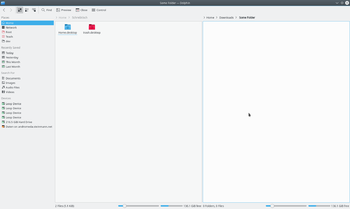
You can split the view with (keyboard shortcut F3). To change back to only one folder view you can use . The symbol will show you which view will be closed. Depending on the currently active view the minus sign will be shown in the left or right part of the symbol. The active view will be closed. This is important to know if you want to use the keyboard shortcut. There is also a button for splitting and closing the view situated in the toolbar. This button displays the minus symbol as well, so it is easy to know which view would be closed.
Of course each view has its own navigation bar and each view can use a different view mode.
Вижте режим
"Делфинподдържа три различни режима на изглед:" Икони "," Подробности "и" Колони ". Това може да се променя от менюто или чрез клавишни комбинации Ctrl +1 (Икони), Ctrl 2 (Подробности) и Ctrl 3 (Колони). Има и бутон за всеки режим на преглед в лентата с инструменти и контекстното меню на папката оглед предлага подменю за промяна на режим на изглед.
Икони
Всеки файл и всяка папка е представена от икона в режим на преглед"Икони". Вместо да се показва икона преглед на файла може да се докаже. Това поведение може да се включва / изключва от менюто или чрез лентата с инструменти бутон. Има ограничение за размера на файла визуализации. Този размер ограничение може да се конфигурира чрез опция . Има и опция за използване на миниатюри вградени във файлове. В KDE 4.5 Преглед са активирани (и максимално определения размер), като
Файловете в избраната папка са подредени по азбучен ред по подразбиране. Начинът на сортиране може да се промени чрез менюто . Следните критерии за сортиране са достъпни:
- Име
* Размер
* Дата
* Разрешения
* Собственик
* Група
* Тип
В допълнение, сортиране последователност могат да бъдат определени от .
Има възможност за показване на допълнителна информация под иконите. Те могат да се включва / изключва чрез . По принцип едни и същи критерии, които са достъпни като критерии за търсене могат да бъдат избрани.
Можете да групирате иконите, за да постигне по-добра представа за това. Това е включено чрез . Сега иконите са групирани както и групите са разделени с хоризонтален ред, съдържащ името на групата като надпис. Разпределението е свързано с избраните критерии за търсене.
=== === Детайли
В режим на преглед"Подробности"допълнителна информация се показва по подразбиране в контраст с оглед вземане на"Икони". Всички файлове са дадени в табличен. В контекстното меню на таблицата заглавието предлага възможност за добавяне на допълнителни колони. Следните колони са достъпни:
- Размер
* Дата * Разрешения * Собственик * Група * Тип Колона"Име" се показва винаги. При щракване върху заглавната част на една от колоните на таблицата ще бъдат сортирани по тази колона. С кликване върху същото заглавие на колона за сортиране последователност се възстановява.
Since KDE 4.1 it is possible to display the folders as a tree. In this mode a plus sign is shown next to the folder. By clicking on this sign the folder is expanded and all containing sub folders and files are also shown in the table but they are attenuated. By clicking the sign, which display a minus now, again the expansion is closed again. Of course the tree structure can be used for as many folders as wished. The tree view is disabled by default, but can be activated via with option .
Columns
View mode "Columns" is inspired by the file manager Finder of Mac OS X. Entering a sub folder does not replace the current folder view but the content of the sub folder is listed in an additional column next to the column of the parent folder. This can be used for several hierarchies, so that you can navigate in an easy and fast way in the file system.
Setting defaults for all folders
Under the menu item you can set any of these attributes to be the default for all folder views.
Panels
Dolphin contains several panels, which can be activated via menu . Each panel can be placed in the left or right docking area. To move a panel you have to click on the header and Drag&Drop the panel. The area where the panel will be placed on mouse released is highlighted. It is possible to stack panels on top of each other. In this case the panels are placed into tabs.
In the header of each panel there are two buttons. The button near to the caption undocks the panel. This makes the panel an independent window which "floats" above Dolphin. The window is still combined with Dolphin and cannot be displayed without Dolphin and cannot for example be minimized like normal windows. By clicking the button again the panel is docked again. The second button will close the panel.
Non Modal Dialogs
When Moving, Copying or Deleting files/directories the dialog disappears even when the operation has not yet completed. A progress bar then appears in the bottom right of the screen, this then disappears also, if you want see the progress you need to click a small (i) information icon in the system tray.
Places
Dolphin contains a new kind of bookmarks Places. These are displayed in a panel which can be activated via (keyboard shortcut F9). The default Places are identical to the one shown in the category System of the K-Menu Kickoff.
By clicking one of these places it will be opened in the current folder view. The context menu offers the possibility to edit the places or to remove them again. It is also possible to hide entries temporarily.
The context menu of a folder can be used to add this folder an another entry to the Places panel. Therefore there is a menu item . You can also Drag&Drop a folder to the Places panel.
The places panel also contains entries to connected removable devices like USB-keys or CDs. A small plug icon indicates if the device is mounted. The context menu offers the possibility to unmount the device.
The places are used as the basis in the breadcrumb navigation bar. Each address is shown in relation to the nearest parent folder which is one of the places.
Information
The information panel can be activated via (keyboard shortcut F11). This panel displays a preview or an icon of the currently selected file/folder or of the file/folder below the mouse cursor. Some additional information like change date or size to the file/folder is displayed as well.
The information panel offers the possibility to rate files, add a comment or tag a file. This is one of the interfaces to the semantic Desktop Nepomuk which provides the advantages of the semantic web for the desktop. Starting from KDE 4.2 it is possible to search for the semantic links given by the tags.
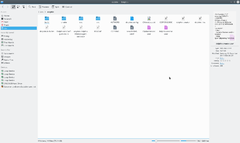
Folders
A panel providing a tree structure for the file system can be displayed via (keyboard shortcut F7). The tree structure offers the possibility by clicking the + and - signs to expand/collapse sub folders. By clicking on one of the folders the content will be displayed in the current view.
Terminal
The terminal emulator Konsole can be displayed directly in Dolphin via (keyboard shortcut F4). This makes it possible to use shell commands directly in Dolphin. The terminal is opened in the folder which is displayed in the current view. Shift + F4 opens Konsole in new window.
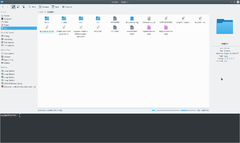
External links
Road to KDE 4: Dolphin and Konqueror
Ars Technica: A First Look at Dolphin
Youtube - KDE 4 rev 680445 - Dolphin
Introducing KDE 4 Blog - Dolphin
Bookmarks and Places
In KDE3 you could create bookmarks in Konqueror, but they were not available to any other application. KDE SC 4.x opens up a great deal more flexibility - but that inevitably means more complication. In fact KDE SC 4 has three classes of Bookmarks, which need to be differentiated. They reside in different files, and have different functions.
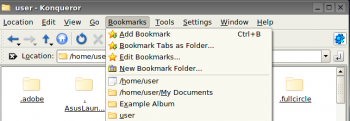
Three kinds of bookmark
First, there is the set of bookmarks available only to Konqueror - web bookmarks. These are stored in ~/.kde/share/apps/konqueror/bookmarks.xml. Then there is a set which Dolphin calls Places. This set is available to all applications as well as the Dolphin file manager. Every time you use you will see this set. The third set of bookmarks are Application Bookmarks. These share one file, regardless of the application that set them, and are available to all applications, unless you restrain them to a specific application. More of that later.
Enable bookmarks
In most distros Bookmarks are not enabled by default. In order to use bookmarks we first have to enable them. Open a in most KDE applications and you will see, at the right-hand edge of the icon panel, a spanner or wrench. From the drop-down list, choose .
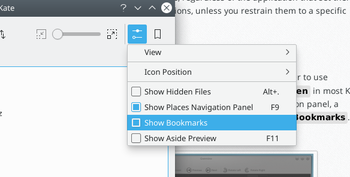
There is a default set of Places -
- Home
- Network
- Root
- Trash
but you can add other places. In Dolphin, right-click on a folder and select , or just drag a folder onto Places.
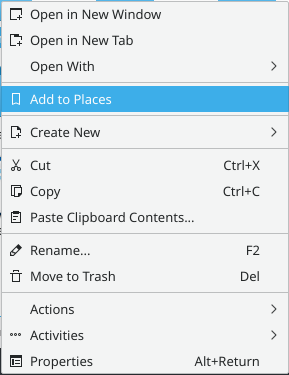
By default this "Place" will be visible in all applications. If you want to keep it constrained to Dolphin, you need to right-click on the new name in the Places list, where you will find the option to Edit it. There is a check-box for .
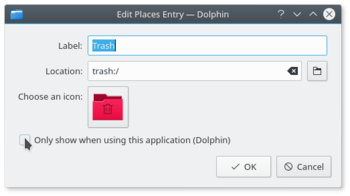
You can see the result of that command if you read ~/.kde4/share/apps/kfileplaces/bookmarks.xml.
In some applications too there is an option in the File menu to add a folder to Places. At this stage, however, applications vary in which features are available. The important thing to remember is that the default is for Places items to be available to all applications in the dialogue.
Bookmarks in applications
This is the second class of bookmarks. Remember opening and using the spanner/wrench? Next to it is a yellow star. This is the bookmark management menu.
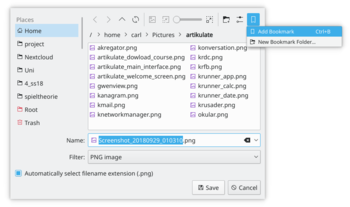
Here you can define bookmarks that will be visible in the same menu on any application. They are stored in one file, ~/.kde4/share/apps/kfile/bookmarks.xml, which is used by all applications having that menu.
Constraining to one application
Some applications allow you to edit items in the Places menu. For instance, if in Gwenview you right click on a folder in Places you can set an option to .
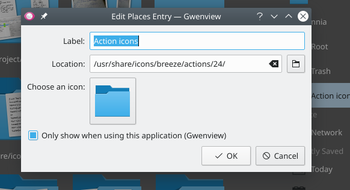
If you need to constrain to an application that does not yet allow you to do that, the only way left is to edit the file ~/.kde/share/apps/kfile/bookmarks.xml. Immediately before the </metadata> tag you will need to add the line
<OnlyInApp>appname</OnlyInApp>
Archive Management in Dolphin
Managing archives now becomes simple. In any directory in Dolphin, highlight the files that you want to compress, and right-click. Here, using the Compress option, you can elect to create a RAR archive, a Gzipped tar archive, or define another compression mode that you have already set up.
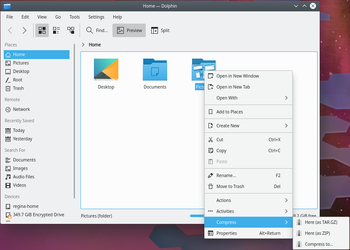
Similarly, if you right-click on an existing archived file you get a range of actions added to the right-click menu. You can extract the archive to the current folder, to an autodetected subfolder or to another place of your choosing.
Should you wish to add files to an existing archive, you can choose .
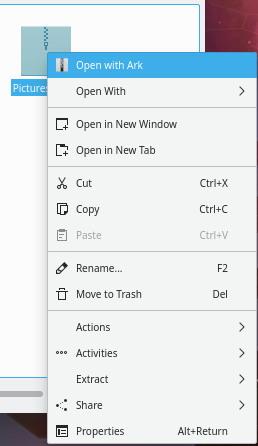
More Cool Actions
Change a File Association on-the-fly
Have you ever wanted to open a file, only to find that it is associated with an application that is not of your choice? You can, of course, alter this in . But Dolphin and Konqueror offer you a quick and cool method for changing a single association.
Right-click on the file and select . The first line there is descriptive, something like:
Type: XML document
At the same level, on the right, there is a spanner (wrench). Click on that and you can add or change an association.
Similarly, by working on a folder, you can change the default file manager to/from Konqueror, if you choose, or add another image browser to the possible associations.
The sub-menu opens up a whole lot more cool things to do from Dolphin. Some possibilities only appear when applicable to the file you have selected. Some of the options are
- Convert an image file to a different format
- Preview the file
- Download a remote file with KGet
- Sign and/or encrypt the file, according to the encryption software installed
Encode and copy audio CD tracks
- Insert an audio CD
- Navigate to this CD in Dolphin: it must appear as "Volume" in your Dolphin 'Places' or you can reach it by typing audiocd:/ in the address bar.
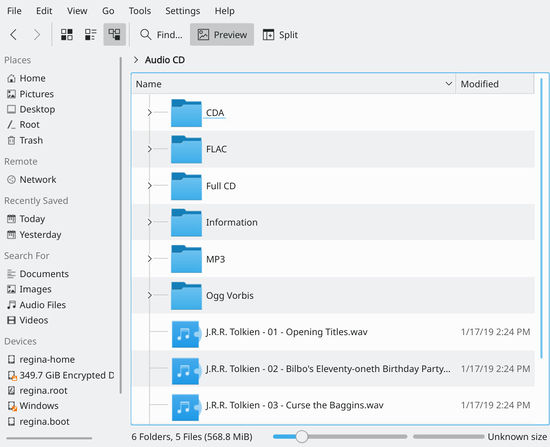
You now notice that Dolphin is proposing a WAV file for each track, plus:
- a CDA folder containing indexing information in the usual CDA format.
- a Whole CD folder, containing one file for each format (.cda, .flac, .mp3, .ogg, .wav) holding all the tracks
- a FLAC folder, containing the tracks encoded into FLAC format (lossless information format)
- an Information folder containing the CDDB informations
- an MP3 folder, containing all the tracks in MP3 format
- a Ogg Vorbis folder, containing the tracks encoded in OGG format
You then just have to copy the folder of your choice, in your preferred format to obtain the relative encoded version of your CD!

